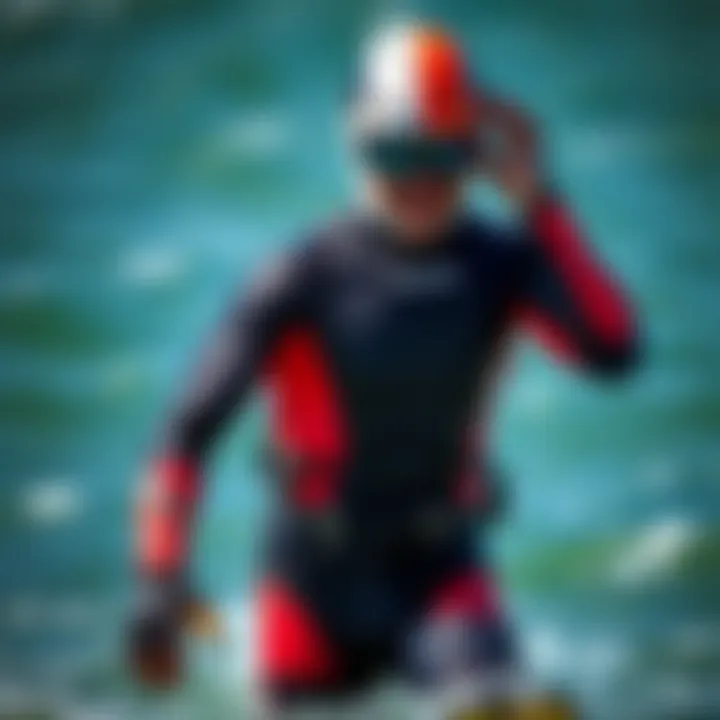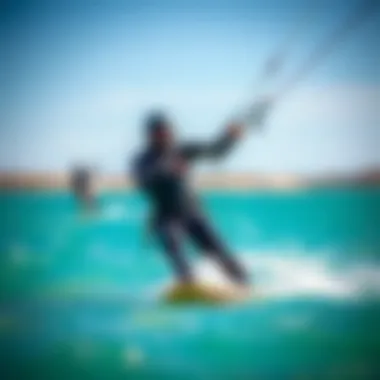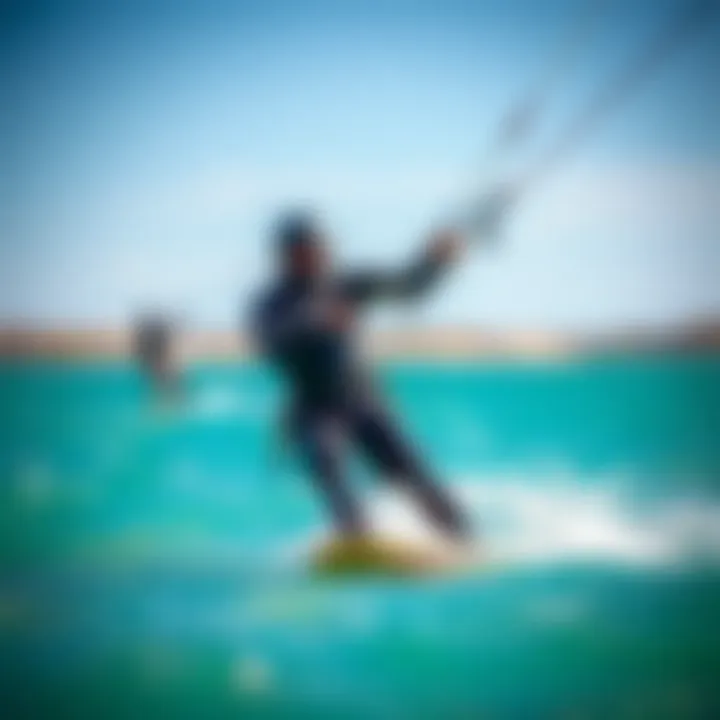The Ultimate Guide to the Warmest Wetsuits for Kiteboarding


Intro
Kiteboarding is not just a sport; it's a wild dance with the wind and waves that many thrill-seekers, both seasoned and newcomers alike, are drawn to. However, when one sets out to embrace the exhilaration of gliding through water, the temperature of that water can pose a significant challenge. Selecting the warmest wetsuit is imperative, not only for comfort but also for performance. This guide will navigate through the must-know elements in choosing the right wetsuit, ensuring that kiteboarders can make informed decisions based on their individual needs and local conditions.
The world of wetsuits can seem overwhelming at first glance, with various materials, thicknesses, and features to consider. But fear not; each feature exists for a reason, tailored to enhance your experience on the water. In this article, we will break down each component, helping kiteboarding enthusiasts select the warmest wetsuit that aligns with the ever-changing nature of their adventures, and we will delve into gear, safety practices, and techniques that ride alongside this choice.
Whether you are gearing up for a vivid sunset session or chasing the morning breeze, having the right wetsuit can transform your kiteboarding experience from a chilly chore to a joyous thrill. With countless options at your disposal, this guide will help distill the essential qualities of a wetsuit into actionable insights, giving you more time to enjoy the exhilarating ride ahead.
Understanding Wetsuits
Wetsuits are not merely pieces of gear; they act as your second skin while kiteboarding. For enthusiasts who thrive on the water, understanding how wetsuits function and what types are available is absolutely critical. Wetsuits protect you against the elements, providing thermal insulation essential for comfort during long sessions in potentially frigid waters. They also give a layer of buoyancy and even a bit of protection against scrapes and bumps that can occur when riding the waves.
Understanding wetsuits means realizing their myriad benefits—not just keeping you warm, but also enhancing performance. The right wetsuit can give you a competitive edge by improving your flexibility, reducing drag, and allowing for better movement. So, whether you are an avid kiteboarder or just getting your feet wet in this thrilling sport, knowing the essential elements of wetsuits can lead to a more enjoyable experience on the water.
Purpose and Functionality
Wetsuits are designed with specific functions in mind, with the primary goal being insulation against cold water. They work by trapping a thin layer of water close to the skin, which then warms up by body heat, providing a shield against the chill. This is crucial for safety; a drop in body temperature can lead to serious conditions like hypothermia.
Moreover, wetsuits are engineered to be form-fitting, which aids in reducing drag. This streamlining helps kiteboarders move more swiftly through the water. If you’re looking into kiteboarding, a well-fitted wetsuit can make a world of difference, quite literally shaping your performance. Think of it as crafting your personal bubble of warmth, that also maintains your agility.
Types of Wetsuits
The world of wetsuits is diverse, with various types tailored for different water activities and conditions. Here’s a straightforward overview:
- Full Wetsuits: These cover the entire body, providing robust insulation and protection. Ideal for colder waters, they come in various thicknesses to cater to varying temperature ranges.
- Shorty Wetsuits: These are shorts on the legs and short sleeves on the arms. They allow for more freedom of movement and are suited for warmer waters.
- Springsuits: These are somewhat like shorties but can vary in sleeve length. They are a perfect compromise for spring and autumn waters where temperatures fluctuate.
- Dry Suits: Not technically a wetsuit, dry suits keep all water out. They are perfect for extremely cold conditions, ensuring that you stay completely dry and warm.
Each type has its distinct purpose, and knowing which one to don can certainly enhance your kiteboarding experience, depending on the weather conditions and water temperature. Choose wisely, as this choice plays a big role in your performance and enjoyment while out on the waves.
"A good wetsuit is lighter than air but heavier than your regrets after a cold session without one."
In the kiteboarding realm, understanding these facets not only enriches your knowledge but also enables you to dive into each session prepared and confident. With the right wetsuit, not only do you protect yourself, but you also unlock greater potential on the water.
Key Features of Warmest Wetsuits
When it comes to kiteboarding, having the right wetsuit can significantly elevate both performance and enjoyment. The key features of the warmest wetsuits play a crucial role in achieving this. They ensure that you stay comfortable, mobile, and warm while navigating through cold waters. Understanding these features is vital for kiteboarders who want to maximize their experience and safety on the water.
Insulation Materials
The materials used in wetsuit insulation are not just trivial details; they can make or break your time spent in chilly waters. The most common types include neoprene, which is flexible while providing excellent thermal insulation. However, not all neoprene is created equal. Higher-quality grades, like limestone neoprene, offer better insulation with less bulk, allowing for greater flexibility during rides.
Additionally, some wetsuits incorporate advanced materials like Thermal Fleece or Air-Flo technology. These materials trap heat and wick moisture away from the body, making them exceptionally effective in retaining warmth throughout your kiteboarding session. It's crucial to understand that the pockets of warmth trapped inside your wetsuit directly affect how comfortable you feel while out there.
Thickness and Warmth Ratings
The thickness of your wetsuit is also a significant factor. Wetsuits typically range from 2mm to 7mm in thickness. A 3/2mm suit, where 3mm refers to the torso and 2mm to the limbs, is often sufficient for warmer waters, while thicker suits are essential for harsher climates. Many manufacturers provide warmth ratings or temperature guidelines, indicating the ideal water temperatures for their products.
In kiteboarding, the wrong thickness can lead either to overheating or, conversely, hypothermia. Understanding your local conditions and matching your wetsuit’s thickness to them is essential. Also, keep in mind that thicker suits can mean less flexibility, which might hinder performance. Finding the right balance is essential for optimal comfort and agility.


Seam Construction Techniques
Seam construction techniques significantly affect not only the durability but also the warmth of a wetsuit. Seams can be stitched, glued, or a combination of both. Glued and blind-stitched seams are particularly favored for warmer suits, as they reduce water entry while maintaining flexibility. When seams are glued, they're layered and then stitched, creating a seal that effectively blocks water but also ensures durability.
On the other hand, flatlock seams are usually less effective in preventing cold water from seeping in, making them more suitable for warmer weather. The construction quality can vastly affect not only the lifespan of the wetsuit but also its thermal efficiency, especially in extreme conditions. Investing in a well-constructed seamless wetsuit can indeed be a game changer.
"The right wetsuit isn't just a piece of gear; it’s a lifeline in cold water, making the difference between discomfort and peak performance."
Overall, paying attention to the key features of wetsuits can provide kiteboarders with the assurance they need to tackle the waters head-on. As you explore various options, consider the insulation materials, thickness, and seam construction, as these elements come together to create an experience that is both enjoyable and safe.
Choosing the Right Wetsuit for Kiteboarding
Selecting the appropriate wetsuit can make or break your kiteboarding experience. It not only influences your comfort but also significantly affects your performance on the water. Choosing the right wetsuit is especially vital given the variable weather conditions and water temperatures kiteboarders often encounter. A well-fitting wetsuit provides insulation, buoyancy, and protection, allowing one to focus on the thrilling aspects of the sport rather than being distracted by discomfort or cold. Thus, understanding the elements that contribute to a suitable wetsuit is essential for all kiteboarding enthusiasts, from novices to seasoned riders.
Factors to Consider
In assessing the ideal wetsuit for kiteboarding, several key factors come into play:
- Water Temperature: Knowing the temperature of the waters you’re likely to be riding in is a crucial first step. For colder climates, thicker wetsuits with increased thermal insulation are essential, while in warmer conditions, thinner suits or shorties may take precedence.
- Wetsuit Type: There are various types of wetsuits such as full suits, spring suits, and shorties. Each serves particular needs based on the water conditions and personal preferences.
- Thickness: Wetsuits come in varying thicknesses, typically expressed in millimeters. This specification indicates how much insulation the suit provides. A suit ranging from 4/3 mm to 5/4 mm is often recommended for colder conditions, while something around 2/2 mm may suffice in warmer waters.
- Material Quality: Not all wetsuit materials are created equally. Neoprene is the standard choice, noted for its flexibility and warmth, but newer alternatives like Yamamoto rubber are emerging, providing greater buoyancy and insulation.
- Seam Sealing Techniques: The way a wetsuit is stitched can impact both comfort and thermal performance. Glued and blind-stitched seams are usually more waterproof than flatlock seams.
Understanding these factors helps kiteboarders make an informed decision, ensuring they feel comfortable and secure while riding the waves.
Fit and Comfort
Fit is arguably the most critical aspect when selecting a wetsuit. A snug but comfortable fit allows for better insulation and prevents water from getting inside, which can rapidly cool the body. Here are some considerations to keep in mind:
- Try Before You Buy: If possible, trying on several suits can reveal invaluable insights about fit and comfort levels. Move your arms, twist your torso, and simulate kiteboarding movements to ensure freedom of movement.
- Body Shape: Wetsuits come in various cuts to accommodate different body shapes. Choose a suit that aligns with your body type to enhance both comfort and performance. Extra features like stretch panels can also provide increased flexibility for active maneuvers.
- Layering Comfort: Depending on where you are kiteboarding and the expected temperatures, consider if you need to layer under the wetsuit. Lightweight thermal layers for colder conditions can be beneficial.
- Adjustability: Lookout for features such as adjustable neck seals and ankle closures. These contribute to a customized fit, reducing the risk of water entry while enhancing warmth.
Adapting Wetsuits to Weather Conditions
Navigating the waters while kiteboarding doesn’t just call for skill and enthusiasm; it also demands that you respond accurately to the elements. Weather conditions play a crucial role in the type of wetsuit you should choose. Adapting your wetsuit selection based on the temperature of the water, along with other environmental factors, ensures optimal comfort and performance during your sessions. Whether you’re riding the waves in chilly conditions or basking in warmer climes, understanding how to tailor your wetsuit choice to the weather is key for any serious kiteboarding enthusiast.
Cold Water Conditions
When the water takes on a frigid persona, kiteboarders need to arm themselves with the right wetsuit. Cold water can sap your energy and lead to rapid temperature loss, so it’s crucial to invest in insulation that won’t quit on you when you need it most.
- Material Selection: Neoprene is the go-to material for cold water wetsuits, with variations like super-stretch neoprene providing flexibility as well as warmth. Look for wetsuits that include materials like Yamamoto neoprene, known for its thermal capabilities and comfort.
- Thickness Matters: A thicker wetsuit generally offers more insulation. For chilly waters, a thickness of 4/3 mm or even 5/4 mm may be necessary. However, be mindful that a bulkier wetsuit can restrict movement, so it’s essential to find a balance that suits your riding style.
- Seam Sealing Techniques: Pay attention to how the seams are constructed. GBS (Glued and Blind Stitched) seams are highly effective at minimizing water entry, while fully sealed seams provide even further protection against those icy splashes.
Cold water can lead to hypothermia faster than a racoon can raid a picnic, making it crucial to layer appropriately and choose the right wetsuit. Investing in gloves and booties is also advisable to keep your extremities warm and functional.
"The right wetsuit can mean the difference between enjoying your session and wishing you were back on the beach with hot chocolate in hand."
Warm Water Considerations
Summer’s shining sun brings a whole different kettle of fish when it comes to wetsuit selection. Warm waters develop a natural allure, but that doesn’t mean any old suit will do.
- Suits with Less Thickness: In warmer waters, generally, a shorty or a wetsuit with a thickness of 2 mm suffices. These lighter suits help you stay comfortable without overheating while ensuring adequate protection against sunburn and stinging jellyfish.
- Breathable Fabrics: Look for wetsuits that use innovative breathable fabrics. Such materials wick moisture away from the body while allowing heat to escape, keeping you comfortable without sacrificing protection.
- Cut and Fit Styles: Think about the varying styles available, like sleeveless options or back-zips that facilitate easy entry and exit. The last thing you want in sweltering weather is to feel trapped in a clammy suit.
Opting for a wetsuit designed for warmer conditions also allows you to enjoy long sessions on the water without feeling like a lobster in a pot. Pair it with proper sun protection to keep your skin safe from those harmful UV rays.


Ultimately, the choice of wetsuit in varying weather conditions could make or break your kiteboarding experience. Knowing how to adapt to your environment ensures that no wave is left unchallenged.
Top Brands for Warmest Wetsuits
Choosing a wetsuit isn't just about finding something that fits. It’s about discovering what brand stands behind the product you’re considering. In the world of kiteboarding, some brands have consistently proven their reliability, favoring both quality and performance. Let's talk about why knowing the right brands can make all the difference.
Leading Manufacturers
When you think about top brands for wetsuits, several names jump out, and for good reason. Each brand comes with its own legacy, understanding of materials, and technology to keep kiteboarders warm and moving freely in the water.
- O'Neill: Often hailed as a pioneer in wetsuit technology, O'Neill exhibits a natural knack for integrating the latest innovations with classic style. Their wetsuits not only offer exceptional thermal protection but also superb flexibility that kiteboarders crave.
- Rip Curl: Known for its relentless pursuit of excellence, Rip Curl’s range features models specifically designed for extreme sports. They maintain a serious commitment to using eco-friendly materials while ensuring that warmth is never compromised.
- Xcel: At the intersection of performance and affordability, Xcel has carved its niche by delivering high-quality wetsuits that cater to every budget. Their unique path to improving heat retention has made them a favorite among experienced riders and newbies alike.
- Billabong: With a strong surf culture lineage, Billabong designs its wetsuits to perform under pressure. They offer styles suitable for various kiteboarding conditions, acknowledging that no two sessions are ever alike.
- Psycho: This brand emphasizes avant-garde design and innovative tech, delivering ultra-lightweight wetsuits that provide warmth without sacrificing mobility. Their meticulous craftsmanship assures riders are well-protected.
Brand Comparisons and Reviews
Delving into brand comparisons offers a clear picture of what each manufacturer brings to the table. Here’s a round-up that highlights particular strengths.
- Warmth vs Flexibility:
- Price Points:
- Eco-friendliness:
- User Reviews:
- O'Neill's advanced insulation techniques often secure a win here. However, the flexibility of Rip Curl's models can slightly tip the scale, especially for kiteboarders performing intricate maneuvers.
- Xcel typically leads when it comes to affordability without skimping on quality. Meanwhile, premium options from Psycho can be on the higher end but offer unmatched technology.
- Rip Curl stands out here, having committed to sustainable practices, whereas O'Neill is making strides but is slightly behind in comparison.
- Many kiteboarders appreciate Billabong's Ward Series for its durability and all-around performance, so it’s worth taking some time to sift through user feedback and testimonials as well.
Most kiteboarders will vouch for the importance of conducting thorough research before a purchase. You may find that personal preferences and experiences vastly affect opinions on brands. Take to forums like Reddit or product review sections on e-commerce platforms for real-world insights.
"A great wetsuit is an investment; choose wisely to ensure many thrilling days ahead on the water!"
Remember to check out the companies’ official websites for specific details on their latest offerings and tech upgrades! By familiarizing yourself with these brands, you arm yourself with the knowledge needed to make informed, strategic decisions about the warmest wetsuit for your kiteboarding adventures.
Wetsuit Maintenance and Care
Proper maintenance and care of your wetsuit is not just a chore; it's a vital part of ensuring your comfort and safety while kiteboarding. A well-maintained wetsuit not only lasts longer but also performs better. When you consistently wear a suit that’s fit for the task, you’ll notice less water seepage, better insulation, and more comfort during those exhilarating rides. By keeping your wetsuit in tip-top shape, you stand to gain numerous benefits, like extending its life and preserving the key features that keep you warm in chilly waters.
Cleaning Techniques
Cleaning your wetsuit sounds straightforward, but it comes with a few nuances that can impact its lifespan.
- Fresh Water Rinse: After every session, it’s essential to rinse your wetsuit in fresh water to remove salt, sand, and any debris that might latch onto the fabric. Salt can deteriorate the neoprene over time, turning it from a cozy second skin to something that feels more like a constricting vice. It's worth your time.
- Use Mild Soap: Once in a while, introducing some mild, wetsuit-safe soap to your cleaning routine can help. Mix it in a tub of cool water and let the suit soak for about 15-30 minutes. This helps to cut through any stubborn grime or odors that a regular rinse might miss.
- Avoid Harsh Chemicals: This is a biggie. Stay clear of bleach, fabric softeners, or even detergents labeled as "heavy duty." All these can wreak havoc on the neoprene, causing it to lose its natural elasticity and waterproofing abilities.
- Drying It Right: After you wash it, hang your wetsuit to dry in a shaded area, away from direct sunlight. Sun exposure can weaken the fabric over time and may cause colors to fade. A good trick is to flip it inside out halfway through the drying process to prevent any dampness that can lead to mildew.
Cleaning your wetsuit properly can feel like a hassle at times, but considering the amount you’ve invested in it—and the chilly waters you often brave—these steps are an absolute must!
Storage Recommendations
When the kiteboarding season winds down or you find yourself taking a break, proper storage of your wetsuit becomes crucial to maintaining its integrity.


- Keep It Cool: A common mistake is tossing your wetsuit in a damp garage or a hot attic. Extreme temperatures and high humidity levels are not friends of neoprene. It’s wise to store your wetsuit in a climate control environment if you can manage that.
- Lay It Flat or Hang: If you’re thinking of hanging your wetsuit, use a wide hanger to prevent stretching. A thin hanger can create unsightly creases that won't disappear easily. If laying it flat, make sure to spread it out in a way that allows air to circulate around it.
- Avoid Folding: Folds can cause creases that remain long after storing. If you can't avoid it, ensure you do it carefully and not on sharp edges that may weaken the fabric over time.
- Check for Pests: Don’t think that just because your wetsuit is made for the water it’s safe from moths or other pests. They can be drawn to neoprene. Ensure your storage space is clean and has pest prevention methods, like mothballs or traps.
Maintaining and storing your wetsuit correctly is crucial in preserving its functions and features. By simply investing a bit of time to care for it, you can ensure that it will look after you in some of the coldest and wildest waters during your kiteboarding adventures.
"Taking care of your gear is just as important as mastering the sport. Neglect your wetsuit, and it won’t perform—or last—like it should."
For more tips on wetsuit care and maintenance, consider checking out resources at Wikipedia or HowStuffWorks.
As you refine your approach to maintenance, remember it’s not just about extending lifespan; it’s about enhancing your entire experience on the water.
Innovations in Wetsuit Technology
Innovations in wetsuit technology play a vital role in enhancing the overall experience of kiteboarding. The advancements not only improve warmth but also contribute significantly to the mobility and comfort of the rider. As kiteboarding enthusiasts are often exposed to varying weather conditions, having a wetsuit that incorporates the latest technology is crucial. Various elements, such as material science, ergonomic designs, and hydrodynamic features, are at the forefront of this revolution, making it an exciting time for those serious about this sport.
Recent Developments
Recent developments in wetsuit technology focus on materials and their functionality. One standout material that has emerged is neoprene, which is now engineered in a multi-layer structure. This construction allows for heat retention while providing flexibility. For instance:
- Graphene-infused Neoprene: Used in brands like Xcel and O’Neill, it not only boosts thermal regulation but also wicks moisture efficiently.
- Eco-friendly Options: Brands like Patagonia are pioneering wetsuits made from plant-based neoprene, reducing the ecological footprint without compromising on warmth.
These innovations are not just about being warm; they cater to the sustainable adventurer who wishes to minimize their impact on the environment. Moreover, improved seam sealing techniques have been developed. Techniques such as liquid seam taped and blind stitching are becoming standard, addressing concerns about leakage and durability. This means your wetsuit can handle demanding environments while keeping you dry—a true necessity for those who kiteboard in less-than-ideal conditions.
Future Trends
Looking ahead, several trends are likely to shape the future of wetsuit technology, signaling an exciting evolution for kiteboarders. Key areas of focus include advanced materials and interconnectedness. Some notable potential trends are:
- Smart Wetsuits: Imagine a wetsuit embedded with sensors that monitor body temperature and hydration levels. Though still in experimental stages, companies are investing in this technology to increase safety on the water.
- 3D Printing: Personalized fits may soon be achievable through 3D printing technology, reducing waste and providing a tailored experience for every rider. This customization means more comfort and efficiency.
- Enhanced Thermal Efficiency: Future materials may utilize phase change materials (PCMs) which react to temperature fluctuations. As the body cools down, the material can release stored heat, providing an even more stable thermal environment.
These innovations frame a future where kiteboarding not only becomes safer but more enjoyable. The next generation of wetsuits promises tailored features that conform not just to body shapes but also the diverse conditions faced by kiteboarders around the world.
For kiteboarders, investing in advanced wetsuit technology could make all the difference. It's not just about staying warm—it's about maximizing performance and enjoying every moment on the water.
The Role of Wetsuits in Safety
When it comes to kiteboarding, safety is paramount. Not only does a well-fitted wetsuit keep you warm and comfortable, but it also serves a crucial role in protecting you from the various dangers that can arise while you’re out on the water. Understanding this aspect can fundamentally enhance your kiteboarding experience, allowing you to focus on the thrill of the ride rather than concerns over your safety.
Hypothermia Prevention
Wetsuits play a critical role in hypothermia prevention, especially in colder water conditions. When you’re kiteboarding, your body is constantly exposed to wind and water, which can quickly sap your body heat.
A good wetsuit provides insulation by trapping a thin layer of water between your skin and the suit. This water gradually warms up due to your body heat, creating a barrier that keeps you warmer than being completely submerged. Here are some important points to consider regarding hypothermia:
- Water Temperature Awareness: In waters below 70°F (21°C), the risk of hypothermia increases. Wetsuits that are thicker, typically those over 4mm, are ideal for such conditions.
- Fit Matters: A wetsuit that’s too loose will allow water to flow in and out, which means you’ll lose heat more quickly. Opt for a snug fit to maximize warmth.
- Consider Multiple Layers: For prolonged exposure in very cold conditions, consider layering with thermal undergarments or wearing a different wetsuit type, like a drysuit, for maximum insulation.
“Being aware of the water conditions and ensuring you have the right equipment can prevent serious health risks.”
In essence, the right wetsuit not only shields against the cold but adds a level of confidence that allows kiteboarders to push their limits without the looming threat of hypothermia.
Protection Against Injuries
In addition to offering warmth, wetsuits provide essential physical protection. When kiteboarding, you frequently encounter varying conditions that could lead to injuries. Here’s how a wetsuit aids in safeguarding you:
- Impact Protection: Wetsuits help absorb impacts from sudden falls or collisions with equipment. They create a buffer that can mitigate bruising or abrasions, which is particularly beneficial when you’re taking jumps or riding in choppier waters.
- UV Protection: Many wetsuits are designed with UV-resistant materials. This feature protects your skin from harmful rays, prolonging your time on the water without the risks associated with sun exposure.
- Thermal Compression: A well-designed wetsuit can facilitate muscle performance by creating gentle compression that supports blood circulation. This can lead to fewer cramps and muscle fatigue, allowing for longer sessions and safer performances.
In summary, a good wetsuit is not merely an accessory, but rather a fundamental piece of safety equipment. Kiteboarders who prioritize safety through proper gear, especially wetsuits, significantly enhance their overall kiteboarding experience, enabling more enjoyment while minimizing risks.



